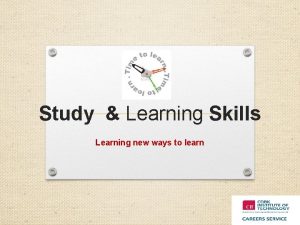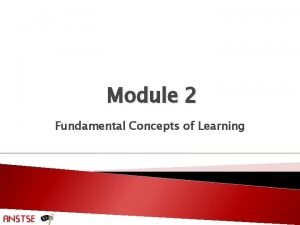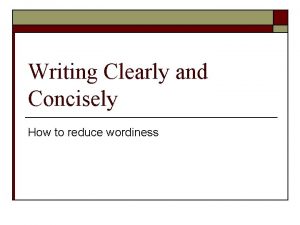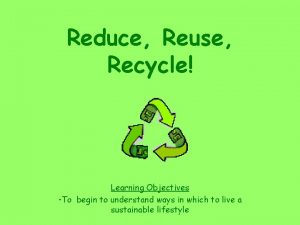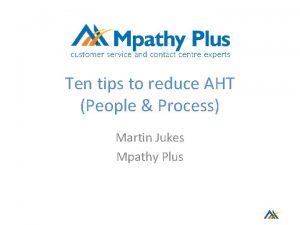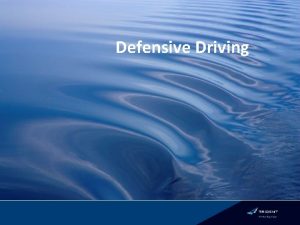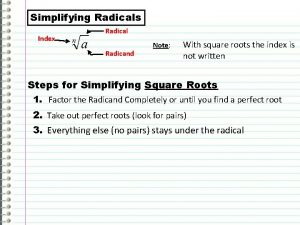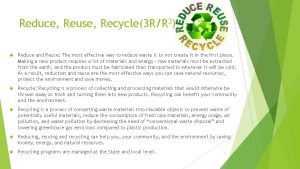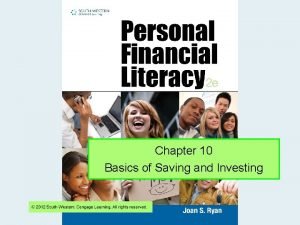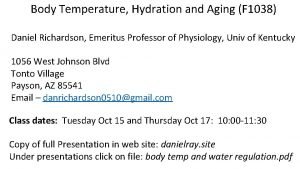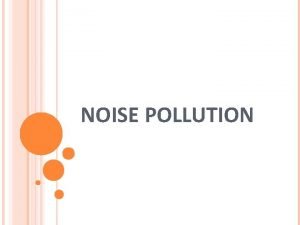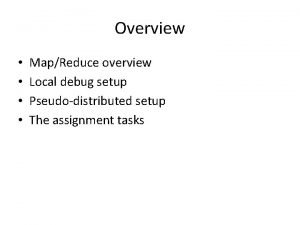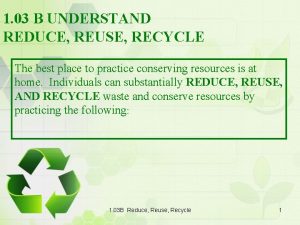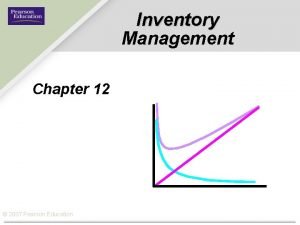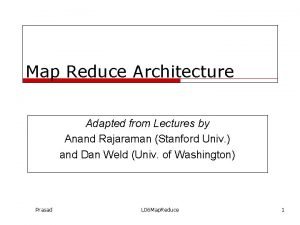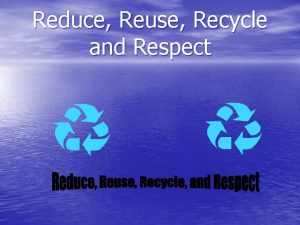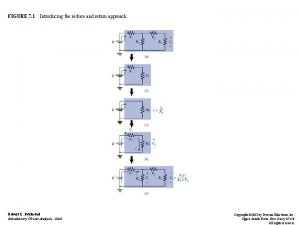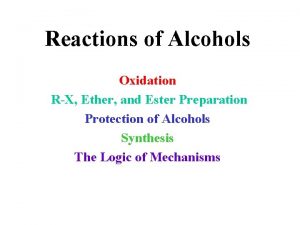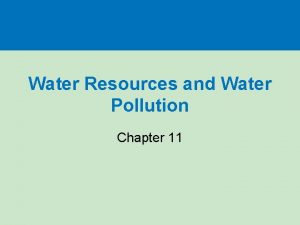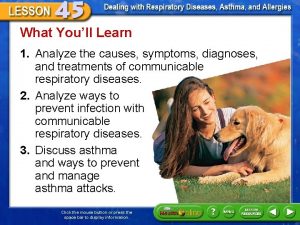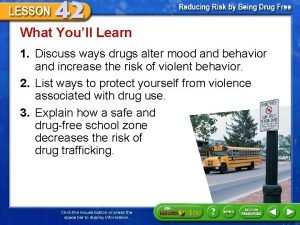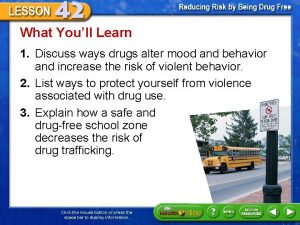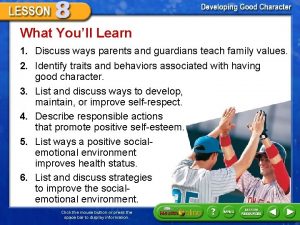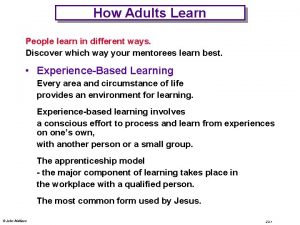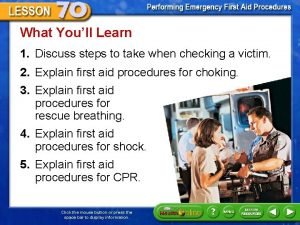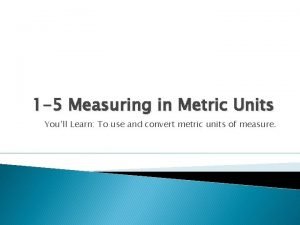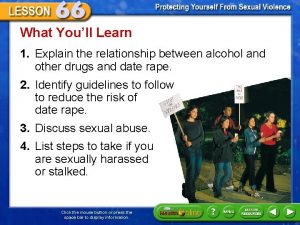What Youll Learn 1 Analyze ways to reduce


























































- Slides: 58

What You’ll Learn 1. Analyze ways to reduce the risk of unintentional injuries in the community. 2. Analyze ways to reduce the risk of unintentional injuries in the home. 3. Analyze ways to reduce the risk of unintentional injuries in the workplace. Click the mouse button or press the space bar to display information.

What You’ll Learn 4. Analyze ways to reduce the risk of unintentional injuries in motor vehicles. 5. Analyze ways a person can reduce the risk of injury from road rage. Click the mouse button or press the space bar to display information.

Key Terms • heat detector • smoke detector • suffocation • repetitive strain injury (RSI) • Occupational Safety and Health Act (OSH Act) • graduated license • high-risk driving Click the mouse button or press the space bar to display information. • child safety restraint • Lower Anchors and Tethers for Children (LATCH) • road rage

Injuries in the Community • An unintentional injury is an injury that results from an accident. • Teens often are injured in the community because they disregard safety guidelines, because peers might influence them to be daring, or because they are stressed or overtired and careless or less alert. Click the mouse button or press the space bar to display information.

What to Know About Unintentional Injuries in the Community • Bicycling – Almost 600, 000 people are treated in emergency rooms for bicycle-related injuries each year. – Most deaths and serious injuries due to bicycling involve head injuries. – The most serious injuries occur when bikes collide with motor vehicles. Click the mouse button or press the space bar to display information.

Ways to Reduce the Risk of Injuries from Bicycling Accidents • Wear a bicycle helmet and shoes. • Obey traffic rules followed by motor vehicle drivers. • Ride on the right, with the flow of traffic. • Check that the bicycle and all safety equipment are in good condition. • Wear clothing that will not get caught in the chain of the bicycle. Wear reflective clothing at night. • Watch for the sudden opening of motor vehicle doors. • Walk the bicycle across busy streets. Click the mouse button or press the space bar to display information.

Ways to Reduce the Risk of Injuries from Bicycling Accidents • Do not ride with another person on the bicycle. • Beware of unsafe road conditions, such as ice and potholes. Click the mouse button or press the space bar to display information.

What to Know About Unintentional Injuries in the Community • Drowning – Many drownings occur in swimming pools and hot tubs. Young children also drown in bathtubs, toilets, and sinks. – Drowning also can result from boating accidents. – Alcohol is a major factor in teen-related drownings and most boating accidents. Click the mouse button or press the space bar to display information.

Ways to Reduce the Risk of Drowning • Learn to swim and have training before participating in water sports. • Never swim or use a hot tub alone and do not leave children alone near water. • Swim only in well-lit designated areas and in sight of a lifeguard. • Stay out of the water in threatening weather. • Leave the water if you have cramps or are tired. • Enforce an alcohol-free policy around water. • Wear a life jacket when participating in water sports. Click the mouse button or press the space bar to display information.

Ways to Reduce the Risk of Drowning • Never boat with others who speed or do not follow safety guidelines. • Do not overload a boat or personal watercraft. • Check the depth of water before entering. • Install a childproof fence around pools. • Do not walk on untested ice. Click the mouse button or press the space bar to display information.

Injuries in the Home • Many accidents that result in unintentional injury and death occur in the home. • A few easy and inexpensive steps can be taken to make the home a safe environment. Click the mouse button or press the space bar to display information.

What to Know About Unintentional Injuries in the Home • Poisoning – Poisoning is a harmful chemical reaction from a substance that enters the body. – Most poisonings in the home result from children swallowing household products and OTC drugs. – Taking very high doses of vitamin and mineral supplements also may result in poisoning. Click the mouse button or press the space bar to display information.

What to Know About Unintentional Injuries in the Home • Poisoning – Some substances cause poisoning when inhaled, such as glue, gasoline, and carbon monoxide. – Carbon monoxide is an odorless, tasteless gas emitted from motor vehicles, gas stoves, heaters, lawn mowers, and chimneys. Click the mouse button or press the space bar to display information.

Ways to Reduce the Risk of Poisoning • Use childproof containers for potential poisons and keep them out of the reach of children. • Place warning stickers on any potential poisons. • Place childproof latches on the doors of all cabinets in which harmful substances are kept. • Do not keep a motor vehicle or a lawn mower running in a closed garage. • Do not use outdoor grills indoors. • Check chimneys for blockage, and have them cleaned regularly. Click the mouse button or press the space bar to display information.

What to Know About Unintentional Injuries in the Home • Falls – Falls can be caused by hazards, such as poor lighting, loose carpets, trailing wires, and unsteady stair rails. – Falls can result in spinal cord injuries. – Teens injured due to falls often have taken unnecessary risks and might have ignored safety precautions or been showing off. Click the mouse button or press the space bar to display information.

Ways to Reduce the Risk of Falls • Do not take risks in high places. • Use a sturdy ladder when climbing. Keep your body in the center of the step and face the ladder when climbing down. • Place an infant or a young child in a playpen, crib, or safety seat when out of your sight. • Use appropriate child safety devices to block stairways and windows. • Be cautious if wearing shoes with slippery soles or high heels. Click the mouse button or press the space bar to display information.

What to Know About Unintentional Injuries in the Home • Fires – Most deaths and injuries related to fire occur in the home. – Home fires often are caused by improper use and disposal of candles, cigarettes, lighters, and matches. – All homes should be equipped with a fire extinguisher, a heat detector, and at least one smoke detector on each floor. Click the mouse button or press the space bar to display information.

What to Know About Unintentional Injuries in the Home • Fires – A heat detector is an alarm that sounds when the room temperature rises above a certain level. – A smoke detector is an alarm that sounds when smoke is detected. – A fire escape plan should be set up in advance, and should include two different ways to escape from each room and a meeting place outside the home. Click the mouse button or press the space bar to display information.

Ways to Reduce the Risk of Fires • Have a no smoking policy in the home to reduce the risk of fires. • Keep all matches, cigarette lighters, and flames out of children’s reach. • Do not overload electrical outlets or run cords under rugs. • Do not leave items, such as irons or electric hair styling products, plugged in for long periods of time. • Do not leave food cooking on the stove unattended; check food cooking in the oven often. Click the mouse button or press the space bar to display information.

What to Know About Unintentional Injuries in the Home • Airway Obstruction – Suffocation is an obstruction of the airway by an external object that blocks the mouth and nose, such as plastic bags, pillows, or blankets. – Choking is the result of an obstruction of the airway by an internal object, such as food or small toys. – Strangulation is the result of external compression of the airway when an object, such as a cord, compresses the neck. Click the mouse button or press the space bar to display information.

Ways to Reduce the Risk of Suffocation • Keep small objects out of the reach of children. • Do not allow children to play with plastic bags or toys that are not appropriate for their age. • Check sleeping infants and children to be sure their breathing is not blocked by a pillow, blanket, or stuffed toy. • Cut food into small pieces that are easy to swallow. • Do not tie a rope or a cord around the neck, even as a joke. Click the mouse button or press the space bar to display information.

What to Know About Unintentional Injuries in the Home Click the mouse button or press the space bar to display information.

Injuries in the Workplace • A work-related injury is any injury acquired while working. • The injury does not have to be the result of one specific event. • Repetitive strain injuries are legitimate workers compensation claims. • Teens are more likely to be hurt on the job than adults. Click the mouse button or press the space bar to display information.

How to Reduce the Risk of Injury in the Workplace • Are there any rules about minors who work? – The Fair Labor Standards Act (FLSA) contains child labor laws to protect the health and safety of minors. – The act limits the hours minors under age 16 can work, and prohibits employing minors under age 18 for certain occupations. Click the mouse button or press the space bar to display information.

How to Reduce the Risk of Injury in the Workplace • What types of injuries occur in the workplace? – Common workplace injuries to teens involve lacerations, contusions, abrasions, sprains and strains, bruises, burns, fractures, and dislocations. – More teen workers are injured than adult workers, even though teens are prohibited from working at dangerous jobs. Click the mouse button or press the space bar to display information.

How to Reduce the Risk of Injury in the Workplace • What is repetitive strain injury? – Repetitive strain injury, or RSI, is an injury that occurs from repeated physical movements. – RSI damages tendons, nerves, muscles, and other soft body tissues. – Symptoms include tingling; tightness; pain and stiffness in hands, wrists, fingers, arms, and elbows; and weakness in hands. Click the mouse button or press the space bar to display information.

How to Reduce the Risk of Injury in the Workplace • What should my employer do to protect my health and safety? – Your employer must meet safety guidelines for healthful working conditions. – The Occupational Safety and Health Act, or OSH Act, is a series of health and safety standards that all employers must meet. – Employees must regularly review safety regulations and new employees must be trained and be made aware of hazards. Click the mouse button or press the space bar to display information.

FLSA Bans for All Minors Under the Age of 18 Hazardous Occupations 1. Manufacturing or storing 7. Power-driven hoisting explosives apparatuses 2. Driving or working as an 8. Power-driven, metaloutside helper on motor forming, punching, and vehicles shearing machines 3. Coal mining 9. Mining, other than coal 4. Logging and sawmilling 10. Power-driven meatprocessing machines, slaughtering, and meat packing plants 5. Power-driven woodworking machines 6. Exposure to radiation Click the mouse button or press the space bar to display information.

FLSA Bans for All Minors Under the Age of 18 Hazardous Occupations 11. Power-driven bakery machines 12. Power-driven paper products machines 14. Power-driven circular saws, band saws, and guillotine shears 15. Wrecking, demolition, and ship-breaking 13. Manufacturing of brick, tile, and related 16. Roofing products 17. Trenching and excavation Click the mouse button or press the space bar to display information.

Motor Vehicle Accidents • Motor vehicle accidents are the leading cause of death for teenagers. • According to the National Highway Traffic Safety Administration, teenagers are involved in three times as many fatal crashes as other drivers. Click the mouse button or press the space bar to display information.

Motor Vehicle Accidents • Four factors that contribute to many motor vehicle accidents are driver behavior, poor roadway maintenance, roadway design, and equipment failure. • Many motor vehicle crashes are caused by excessive speed or aggressive driver behavior. Click the mouse button or press the space bar to display information.

Safety Guidelines to Reduce the Risk of Motor Vehicle Accidents • How can I obtain a valid driver’s license? – You must pass a written test and a driving test. Some states require many teens to take a driver education course to gain knowledge and skills needed to pass these tests. – A learner’s permit is an authorization to drive when supervised by a licensed driver of a certain age with no other passengers in the motor vehicle. Click the mouse button or press the space bar to display information.

Safety Guidelines to Reduce the Risk of Motor Vehicle Accidents • How can I obtain a valid driver’s license? – A graduated license is a conditional license given to new drivers that restricts driving privileges, such as being allowed to drive only during the day. – The likelihood of accidents during the first year of driving is high. Click the mouse button or press the space bar to display information.

Safety Guidelines to Reduce the Risk of Motor Vehicle Accidents • What does it mean to be a defensive driver? – A defensive driver is a driver who guards against the unsafe actions of other drivers. – Defensive driving includes: • Obeying traffic laws, including speed limits. • Anticipating what other drivers might do and being prepared to act quickly. • Never tailgating. • Staying alert and avoiding distractions. Click the mouse button or press the space bar to display information.

Safety Guidelines to Reduce the Risk of Motor Vehicle Accidents • Driving safely – High-risk driving is dangerous driving that can result in crashes. – It includes behaviors, such as speeding, trying to beat red lights or a train, racing other drivers, jumping hills, and drinking and driving. – Do not ride in a motor vehicle with a driver who chooses high-risk driving. Click the mouse button or press the space bar to display information.

Safety Guidelines to Reduce the Risk of Motor Vehicle Accidents • Are there ways to avoid hitting deer? – Motorists most often hit animals at dusk and at dawn. – Stay alert and control your speed. – If you see an animal in the road, honk your horn with one long blast and do not flash your lights. – Look for other deer. Click the mouse button or press the space bar to display information.

Safety Guidelines to Reduce the Risk of Motor Vehicle Accidents • Do I need to wear a safety belt if my vehicle has an air bag? – An air bag is a cushion that inflates upon impact and prevents people from being thrown into the wheel, dashboard, and windshield. – A safety belt is a seat belt and shoulder strap. – Air bags are not a substitute for safety belts. – Safety belts should be worn by the driver and passengers at all times. Click the mouse button or press the space bar to display information.

Safety Guidelines to Reduce the Risk of Motor Vehicle Accidents • Is it ever safe to drink and drive? – No. Drinking alcohol is the leading cause of motor vehicle accidents for teens. – Alcohol impairs judgment, reaction time, and motor skills. – Drinking is a leading cause of high-risk driving. Click the mouse button or press the space bar to display information.

Safety Guidelines to Reduce the Risk of Motor Vehicle Accidents • What should I do if I suspect that someone who is driving has been drinking? – Even if an adult who has been drinking insists he or she is OK, call your parents, guardian, other responsible adult, or a taxi for a ride. Click the mouse button or press the space bar to display information.

Safety Guidelines to Reduce the Risk of Motor Vehicle Accidents • I will be driving my younger siblings to day care. What actions should I take to ensure their safety? – All children under the age of 12 should ride in the backseat of a motor vehicle and all infants and small children must be placed in a child safety restraint. – A child safety restraint is a child safety seat designed for a small child that is secured in the backseat of a motor vehicle. Click the mouse button or press the space bar to display information.

Safety Guidelines to Reduce the Risk of Motor Vehicle Accidents • I will be driving my younger siblings to day care. What actions should I take to ensure their safety? – Lower Anchors and Tethers for Children, or LATCH, is a restraint system designed to work independently of the vehicle’s safety belt system to simplify child safety seat installation and reduce misuse. Click the mouse button or press the space bar to display information.

Safety Guidelines to Reduce the Risk of Motor Vehicle Accidents • Consequences of a traffic violation – A traffic violation is any violation of the current traffic laws. – After a certain number of traffic violations, a driver’s license can be revoked for a period of time or a person may have to attend additional driver education classes. – Serious violations may result in imprisonment or fines. Click the mouse button or press the space bar to display information.

Safety Guidelines to Reduce the Risk of Motor Vehicle Accidents • How safe are sport utility vehicles (SUVs)? – SUVs and large trucks are high-riding vehicles that, in a crash, can override the bumpers on a smaller motor vehicle and strike occupants in the chest or head. – SUVs are more likely than cars to flip over if the driver loses control. Click the mouse button or press the space bar to display information.


Motor Vehicle Violence • Teens need to protect themselves from violence while they are driving or riding in motor vehicles. • Some people pretend to be helpful and then assault people who have motor vehicle trouble. Click the mouse button or press the space bar to display information.

What to Know About Motor Vehicle Violence • Road rage – Road rage is any display of aggression by an angry or impatient driver or passenger of a motor vehicle. – Examples include verbal abuse, hand gestures, intimidating stares, driving in an intimidating manner, throwing objects at or bumping other vehicles, and threatening another driver. Click the mouse button or press the space bar to display information.

What to Know About Motor Vehicle Violence • Road rage – To prevent provoking other drivers and passengers, you should avoid eye contact with an aggressive driver, stay calm, do not react to a person trying to provoke you, keep a safe distance from people driving unpredictably. – Report incidents of road rage to the police or call 911. Click the mouse button or press the space bar to display information.

What to Know About Motor Vehicle Violence • Carjacking – Carjacking is motor vehicle theft that occurs by force, or threat of force, while the driver and/or passengers are still in the motor vehicle. Click the mouse button or press the space bar to display information.

Ways to Prevent Motor Vehicle Violence • Have a cell phone to use in case of emergency. • Keep the fuel tank full and your vehicle in good condition to prevent breakdowns. • Carry a flashlight, road flares, and a “send help” sign in case your vehicle breaks down. • Stay in your vehicle and keep your doors locked and your windows rolled up if someone other than a police officer stops to offer help. • Never leave children in an unattended vehicle. • Never leave keys in the ignition or the engine running. • Lock your vehicle at all times and keep your keys with you. Click the mouse button or press the space bar to display information.

Ways to Prevent Motor Vehicle Violence • Keep valuables out of sight. • Check the seats and the floor before getting into a vehicle. • Try to drive and park in safe, well-lighted areas. • If you think you are being followed, go to a public place and call the police. • Keep your vehicle in gear when at a stoplight. • Be cautious of anyone approaching your vehicle when it is stopped. • Drive to a nearby phone and call 911 if someone needs help. Click the mouse button or press the space bar to display information.

Ways to Prevent Motor Vehicle Violence • Do not resist if an armed person demands your vehicle. • Get a latch for the inside of your trunk so that you can escape if forced inside. • Never hitchhike or pick up a hitchhiker. Click the mouse button or press the space bar to display information.

Study Guide 1. Identify the following statements as true or false. _______ SUVs are more likely than cars to flip over if true the driver loses control. _______ Serious traffic violations, such as driving true without a license and/or driving under the influence, may result in imprisonment or fines. _______ false Child safety seats should be secured in the front seat of the vehicle. _______ Air bags are not a substitute for safety belts. true Click the mouse button or press the space bar to display information.

Study Guide 2. Fill in the blank with the appropriate term from the lesson. traffic violation A. A _______ is any violation of the current traffic laws. learner’s permit B. A _______ is an authorization to drive when supervised by a licensed driver. C. Choking _______ is the result of an obstruction of the airway by an internal object. Click the mouse button or press the space bar to display information.

Study Guide 3. What is carjacking? Carjacking is motor vehicle theft that occurs by force, or threat of force, while the driver and/or passengers are still in the motor vehicle. Click the mouse button or press the space bar to display information.


Lesson Resources Web Quest Project Web Links Self-Check Quiz www. glencoe. com Go to www. glencoe. com to find Health & Wellness Web resources.

To navigate within this Interactive Chalkboard product: Click the Forward button to go to the next slide. Click the Previous button to return to the previous slide. Click the Lesson Resources button to go to the Lesson Resources slide where you can access resources, such as transparencies, that are available for the lesson. Click the Menu button to close the lesson presentation and return to the Main Menu. If you opened the lesson presentation directly without using the Main Menu, this will exit the presentation. You also may press the Escape key [Esc] to exit and return to the Main Menu. Click the Help button to access this screen. Click the Health Online Button to access the Web page associated with the particular lesson you are working with. Click the Speaker button to hear the vocabulary term and definition when available.

This slide is intentionally blank.
 Ways to reduce poverty
Ways to reduce poverty Analyze the ways in which the vietnam war heightened social
Analyze the ways in which the vietnam war heightened social Kinesthetic learners definition
Kinesthetic learners definition New ways to learn
New ways to learn Thpes of learning
Thpes of learning Gods ways are not our ways
Gods ways are not our ways Map reduce paper
Map reduce paper Mapreduce combiner
Mapreduce combiner Java map reduce
Java map reduce Eliminate reduce raise create grid
Eliminate reduce raise create grid How to reduce wordiness
How to reduce wordiness Osgoods model
Osgoods model Reduce reuse recycle objectives
Reduce reuse recycle objectives Reduce the block diagram to canonical form
Reduce the block diagram to canonical form Map reduce types
Map reduce types Cognitive dissonance
Cognitive dissonance Tips to reduce aht
Tips to reduce aht The ratio used to enlarge or reduce similar figures
The ratio used to enlarge or reduce similar figures Follow the four r's read right reduce and ride when
Follow the four r's read right reduce and ride when How to reduce climate change
How to reduce climate change Index of the radical
Index of the radical Java map reduce
Java map reduce 3r reduce reuse recycle
3r reduce reuse recycle Chapter 10 basics of saving and investing
Chapter 10 basics of saving and investing Excess heat reduce
Excess heat reduce Noise pollution solution
Noise pollution solution Map-reduce
Map-reduce Algebra y sus partes
Algebra y sus partes Make a poster reduce reuse recycle
Make a poster reduce reuse recycle Document
Document The primary lever to reduce anticipation inventory is to
The primary lever to reduce anticipation inventory is to Lisp map reduce
Lisp map reduce Reduce reuse recycle respect
Reduce reuse recycle respect How ball bearings reduce friction
How ball bearings reduce friction How to reduce solid waste
How to reduce solid waste Methods of water pollution
Methods of water pollution Reduce stress
Reduce stress Map-reduce
Map-reduce Map reduce word count
Map reduce word count How to reduce a reducible representation
How to reduce a reducible representation How to reduce mips in mainframe
How to reduce mips in mainframe Eliminate-reduce-raise-create examples
Eliminate-reduce-raise-create examples Boylestad
Boylestad Reduction to common denominator
Reduction to common denominator Simplify it
Simplify it Excess heat reduce
Excess heat reduce 9 block diagram
9 block diagram Reduce examples pictures
Reduce examples pictures Regularity in vlsi design is defined as
Regularity in vlsi design is defined as Using citys heat reduce emissions
Using citys heat reduce emissions Mapreduce شرح
Mapreduce شرح Naocl reaction with alcohol
Naocl reaction with alcohol Molecular sieve
Molecular sieve Policies to reduce unemployment
Policies to reduce unemployment Disadvantages of appropriate technology
Disadvantages of appropriate technology Google map reduce
Google map reduce Mapreduce: simplified data processing on large clusters
Mapreduce: simplified data processing on large clusters Blender decimate planar
Blender decimate planar How to overcome water pollution
How to overcome water pollution



